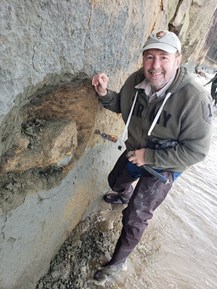Prehistoric Dolphins at Washington’s Birthplace
While poking around the edges of yesterday’s posting on young George Washington and dolphins, I came across a news story I missed last year.
On 16 March 2020, the National Park Service staff at the George Washington Birthplace National Monument in Fredericksburg, Virginia, waded into a situation with the help of paleontologists.
I knew that N.P.S. historic sites have strict rules about arranging for archeological study before starting any excavation or construction to be make sure no useful finds are destroyed. I hadn’t thought about the rules for capturing even older scientific evidence, but of course the same principles would apply.
The Washington Birthplace site sits next to the Potomac River, or actually a bit above it, which explains the need for paleontolgists:
The paleotologists dated those fossils to fifteen million years ago. For Washington, that would have been an unbelievably long time. Educated Americans of his era were still learning about the world being less than five thousand years old.
Nonetheless, Washington was very curious about fossil discoveries, as Mount Vernon discusses. Like his fellow Virginia Thomas Jefferson, Washington was particularly interested in signs that elephant-like mastodons lived in North America.
In 1770, Washington wrote in his diary about a place along the Ohio River “Where the Elephants Bones were found.” Two years later, land speculator Dr. John Connolly sent him a fossil tooth from Big Bone Lick, writing, “I just stumbled upon the tooth I now present you with.”
In the winter of 1780, during the long stand-off with the British in New York, Gen. Washington and some of his officers took time to visit a site in Orange County where a ditch digger had unearthed bones and teeth. The man who owned that land, the Rev. Robert Annan, wrote that the commander-in-chief “told me, he had in his house a grinder which was found on the Ohio.”
I therefore think that Washington would have been intrigued and even excited by the news that deep below his childhood home were the fossilized bones of extinct dolphins.
On 16 March 2020, the National Park Service staff at the George Washington Birthplace National Monument in Fredericksburg, Virginia, waded into a situation with the help of paleontologists.
I knew that N.P.S. historic sites have strict rules about arranging for archeological study before starting any excavation or construction to be make sure no useful finds are destroyed. I hadn’t thought about the rules for capturing even older scientific evidence, but of course the same principles would apply.
The Washington Birthplace site sits next to the Potomac River, or actually a bit above it, which explains the need for paleontolgists:
For several years park rangers have been regularly monitoring the emergence of fossils within the rapidly eroding cliffs along the shoreline at the monument. Some barely exposed fossil bone discovered and documented the previous year, by the monument’s chief ranger Tim Sveum and NPS paleontologist Justin Tweet, was now more visible revealing identifiable skeletal remains.The rapidly exposed fossil turned out to be from a form of extinct long-nosed dolphin in the Eurhinodelphinidae family. Furthermore, whle the scientists collected that specimen, they also found “a second and more complete fossil dolphin skull” nearby.
Monitoring and repeat photography of the freshly exposed fossils was undertaken by park ranger Wesley Spurr who observed that the high rate of erosion resulted in the loss of three bone elements over a two-week period.
Photos of the fossils visible at the surface were forwarded to paleontologists Vincent Santucci and Justin Tweet (NPS Paleontology Program), and Stephen Godfrey (Curator of Paleontology, Calvert Marine Museum), who confirmed the remains of the ancient marine mammal. It was also apparent that these important fossils were “at risk” and in imminent danger of being swept away.
The paleotologists dated those fossils to fifteen million years ago. For Washington, that would have been an unbelievably long time. Educated Americans of his era were still learning about the world being less than five thousand years old.
Nonetheless, Washington was very curious about fossil discoveries, as Mount Vernon discusses. Like his fellow Virginia Thomas Jefferson, Washington was particularly interested in signs that elephant-like mastodons lived in North America.
In 1770, Washington wrote in his diary about a place along the Ohio River “Where the Elephants Bones were found.” Two years later, land speculator Dr. John Connolly sent him a fossil tooth from Big Bone Lick, writing, “I just stumbled upon the tooth I now present you with.”
In the winter of 1780, during the long stand-off with the British in New York, Gen. Washington and some of his officers took time to visit a site in Orange County where a ditch digger had unearthed bones and teeth. The man who owned that land, the Rev. Robert Annan, wrote that the commander-in-chief “told me, he had in his house a grinder which was found on the Ohio.”
I therefore think that Washington would have been intrigued and even excited by the news that deep below his childhood home were the fossilized bones of extinct dolphins.


No comments:
Post a Comment